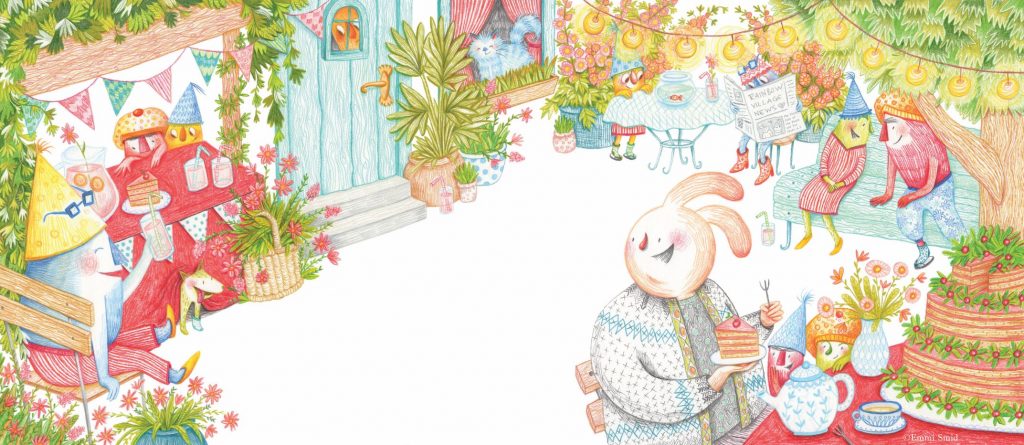
One day a friend I met at university messaged me that he was passing through town, and whether I fancied meeting up. We hadn’t seen each other for a couple of years and he mentioned that he looked a bit different from how I might remember him. I didn’t think anything of it. When he showed up at my door he did indeed look a bit different. He’d shaved off his beard, wore eye make-up and nail varnish, and rocked a figure-hugging top. I still didn’t think anything of it. Having studied art at university and, at the time, living in the colourful bubble of Brighton (UK), I was used to people around me not really ascribing that much meaning to gender stereotypes. It wasn’t until halfway through our conversation that it suddenly hit me: my friend looked different, not because he’d simply fancied shaving off his beard and trying out a new, more feminine look; he looked different because he was in fact a woman, not the man I’d met at university!
I didn’t write Rainbow Village in an attempt to tell you my friend’s story – to whom I referred to as ‘he/him’ up until now, only for the purpose of not confusing the anecdote. Her story obviously remains hers to share. I wrote Rainbow Village because my friend’s transition made me aware of something I hadn’t been aware of before, simply because I never had to be: I never questioned my gender, because I am blessed with the fact that my biological sex is in line with how I look physically and how I feel inside my body and mind. But what does one’s inner world look like when this isn’t the case? How does it shape one’s personality and outlook when you are treated as something or someone other than who you truly are? And why can it be so hard for others to accept someone else the way they are? What effect does this have on the person who has to cope with other people’s inability to accept them as their true selves?
These and other questions provoked by my friend’s personal experience danced through my head and gave me this urge to want to explore deeper, as they triggered my lifelong interest in the topic of ‘The Other’. This fascinates me, not just because all that is ‘other’, and thus ‘different’ from me creates this exciting tension in my tummy to which I know the relief lies within learning and understanding more about the other, but also because I am aware that anything that is ‘other’ serves as my mirror: I am not without you. Our dynamics with those around us and the people that we meet on our path shape us – we are never a finished piece of work. That’s not to say that we don’t or shouldn’t own a healthy sense of self, but as humans we tend to thrive when we feel a sense of safety and belonging. We need each other, and thus we (subconsciously) internalise the social identities of the groups we are involved with: our gender identities, class identities, cultural identities, ethnic identities, sexual identities, and so on, and this informs our thinking of ourselves and how we’d like to be perceived by others.
Our brains and nervous systems are wired to perform the job of keeping us safe, so it is in fact healthy that alarm bells go off inside our bodies and minds when we come across something that is ‘other’ to what is familiar to us. It requires conscious commitment to cultivate our understanding of others -their backgrounds, perspectives and inherent struggles- yet it is the key to embracing diversity. The question is: why should we want to embrace diversity if we feel safe and happy inside the bubbles we live in? I shouldn’t like to tell you how to live your life –that’s your business, not mine. I can only speak for myself when I say that aiming to make a point of approaching the other with curiousity enriches my life and thinking, deepens my empathy, and thus supports the opportunity to create a narrative that stems from a place that holds space for ‘we and us’, instead of ‘me against you’ and ‘us against them’. I certainly do not feel the need to be besties with the whole world, but when you’re on board with me, we’ll both have extended our circle of people we trust, feel safe with and learn from. Win-win, in my eyes. Long story short: it’s a life-long learning curve, but cultivating a little trust and compassion goes a long way.
So – with a big thanks to my friend for being courageous enough to unapologetically be herself, share her inner world and her journey with me, and in turn inspiring and enriching me – here’s a book about celebrating diversity, which I dedicate to her with all my love!

Emmi Smid is the author and illustrator of Rainbow Village, publishing on the 21st August 2020. She has also published Luna’s Red Hat and is the illustrator of Minnie and Max Are OK! You can follow her on Instagram here.